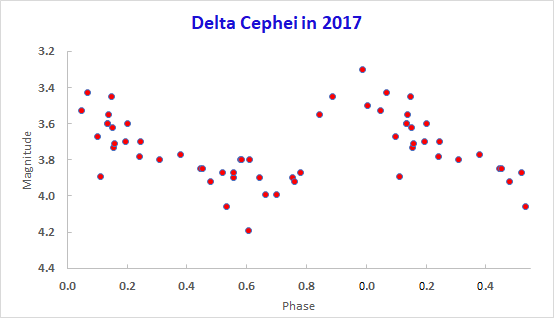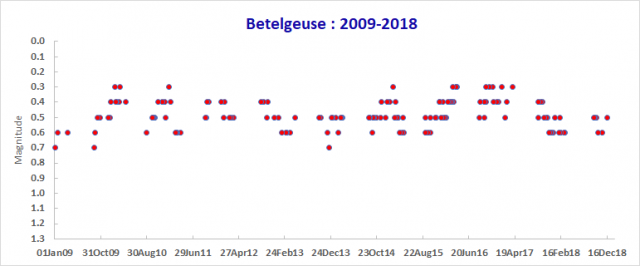Forum Replies Created
-
AuthorPosts
-
21 April 2025 at 9:41 am in reply to: Message from NBC news – are our skies becoming more ‘starry?’ #629655
 Tracie HeywoodParticipant
Tracie HeywoodParticipantI wonder whether the impression of the sky looking more start was a consequence of three bright planets being on view during the evenings? My initial impression of the night sky being clear is always stronger when I am looking towards Orion and Sirius than when I am looking towards blander constellations such as Cetus or Hydra.
Over the years, my impression has been that daytime blue skies have more milky, presumably due to an increase in aircraft contrails that gradually spread out. A notable exception being in the early weeks of lockdown in 2020 when there were few aircraft flying.
In contrast, during runs of clear nights, haze seems to be less of a problem than it was 40 years ago. Then, I could get a couple of useable nights before the haze became too bad. Nowadays, this happens much less often. Maybe due to a reduction in air pollution? Tracie HeywoodParticipant
Tracie HeywoodParticipantand, of course, submit those observations, which have been loitering in your log book or on your laptop, to the relevant observing section !
 Tracie HeywoodParticipant
Tracie HeywoodParticipantI can’t comment on V light curves, but I am always wary of visual estimates of the magnitude of Megrez. The comparison stars typically used (alpha Dra, chi UMa, psi UMa, lambda Dra) are quite a distance away on the sky from Megrez and can for much of the year be at significantly different altitudes and thus affected differently by any haze present. This inevitably affects the reliability of visual estimates made under such conditions and increases the visual light curve scatter. (This issue also affects other ‘isolated’ stars such as epsilon Peg, for which there have been claims of large brightness changes over the years). It is also the case that visual magnitudes made when the star or its comparisons are close to the limit of visibility show more scatter than when the stars involved are easily seen.
 Tracie HeywoodParticipant
Tracie HeywoodParticipantHi Mike,
I’m not aware of any radio specific programmes within the BAA Meteor Section, but it would be worth checking with the BAA Radio Group.
Shower identification is primarily in the domain of radar rather than forward scatter radio methods, but the continuous monitoring of radio meteor counts can pick out and draw attention to unexpected bursts of activity. Many radio meteor observers submit their data to https://rmob.org/index.php
 Tracie HeywoodParticipant
Tracie HeywoodParticipantI’m a visual observer rather than a radio observer, but I’ll reply as best I can.
To quote from the (forward scatter) radio observing notes in use during my time as SPA Meteor Section Director:
“Radio meteor detection does not differentiate between shower meteors and sporadics and therefore your counts will represent the total meteor activity detected. The number of echoes detected will depend on many factors, including the sensitivity of your equipment, your distance from the transmitter, the direction of the shower radiant relative to the transmitter and your receiver, and, of course, the activity level of the meteor shower. The more sensitive radio systems are also capable of picking up echoes related to particles smaller than those that produce naked eye meteors and therefore the relative strengths of meteor showers seen by radio observers can differ from those seen by visual observers.”
Combining the count numbers seen by different observers is therefore difficult, but different observers should agree on the timing of any spikes in rates.
What can and can’t be seen in terms of radio echo counts is illustrated well by Bill Ward’s echo count graphs in this SPA report for the 2016 Perseid peak https://www.popastro.com/main_spa1/meteor/perseids-2016-more-reports/
Hence, my impression is that meteor radio echo counts primarily provide an interesting additional source of information that can be viewed alongside visual and video observing reports (and radio observations are of course are a useful fallback for observers frustrated by overcast skies).
 Tracie HeywoodParticipant
Tracie HeywoodParticipantHi Paul, I have no doubt that beginners will “see” delta Cephei change in brightness. The question is whether these changes match the brightness variations of delta Cephei or whether they primarily reflect the largish scatter that is common in newcomers to visual observing. The UK weather is such that it is unusual for there to be 5 or more clear nights in a row. Hence observers are unlikely to follow delta Cephei through a single cycle of variation and instead will have a collection of adhoc observations spread over a period of time. I know from my early experience that converting such sets of observations into a single light curve can produce somewhat disappointing results, with many observations straying a long way from the (hoped for) neat light curve. The 2017 light curve that I included in my previous reply was, in contrast, primarily based on observations by SPA VSS members with many years experience.
Tracie (based in Leek, Staffs, not north Wales!)
 Tracie HeywoodParticipant
Tracie HeywoodParticipantI’m always wary of the idea that making naked eye observations of variable stars is *still* a good way of introducing beginners.
Although several, such as delta Cephei, are visible with the naked eye from many locations in the UK, to make an accurate observation requires both the variable and comparison to be *easily* visible. Given that delta Cephei goes down to about mag 4.3 means that you need a limiting magnitude approaching 5.5. Personally, despite my observing site more or less achieving this in moonless skies, I find it easier to observe delta Cep using smaller binocular sizes nowadays.
Given that visual observations inevitably “jump around” a bit, especially for inexperienced observers, one thing that is needed is persistence – as it can take many observations before the saw-tooth pattern emerges from the “scatter”. The accompanying light curve shows SPA VSS observations of delta Cephei from 2017.
Fortunately nowadays, PC software makes the plotting of light curves a lot easier – no “folding” of light curves is required. The SPA VSS has a spreadsheet that can be downloaded: http://www.popastro.com/documents/DeltaCephei_phase_calc_blank.xlsx
You enter the dates, times and magnitudes. It then does the conversions and plots the phase-based light curve for you.

 Tracie HeywoodParticipant
Tracie HeywoodParticipant As can be seen from this photo I took in Tanzania in 2013, giraffes are so tall that they have to reach down to the tree tops … or maybe the “trees” in the photo are really just bushes
As can be seen from this photo I took in Tanzania in 2013, giraffes are so tall that they have to reach down to the tree tops … or maybe the “trees” in the photo are really just bushes Tracie HeywoodParticipant
Tracie HeywoodParticipantI was able to observe on 126 nights (35%) when I was in Leek compared with 110 nights (31%) in 2017 and 128 (37%) in 2016. Observing was only possible after midnight on 33 of these nights.
Whether a night is usable for observing obviously depends on that you are trying to observe. Meteor observing requires long clear spells (these are much rarer in Leek than when I used to observe from East Yorkshire or Oxfordshire), while VS observing can make use of short-lived breaks. Observing using binoculars also greatly reduces my “set up” time. VS observing is hindered by moonlight, but much less so than meteor observing.
May and July were by far the best months (if only the nights had been longer!). March and December were worst. Variable star totals are well up on 2017, but all major meteor shower maxima were clouded out.26 December 2018 at 11:55 am in reply to: Did Aboriginal Australians Discover the Variability of Betelgeuse? #580438 Tracie HeywoodParticipant
Tracie HeywoodParticipant I do sometimes wonder how much experience authors of articles such as this have of the stars that they are writing about.
I do sometimes wonder how much experience authors of articles such as this have of the stars that they are writing about.Yes, as the author states “it is easy for inexperienced observers to detect the variability of Betelgeuse over its range in brightness from V = 0.0 to V = 1.3“. However, the key word here is “inexperienced”. Are they really detecting changes in the brightness of Betelgeuse itself, or is it just scatter due to inexperience?.
The major challenge regrading visual monitoring of Betelgeuse is that with it being one of the brightest stars, its comparison stars such as Procyon are a long away from it on the sky – and thus potentially affected to a different extent by factors such as haze. It is easy to “see” Betelgeuse to be “significantly brighter than Procyon” , when Procyon is somewhat lower in the eastern sky and dimmed by haze or “greatly fainter than Procyon” when Betelgeuse is somewhat lower in the western sky.
I have included my light curve from the past 10 years to illustrate that the normal range of Betelgeuse is no more than a few tenths of a magnitude. My observations of Betelgeuse go back around 40 years and, other than when observed under poor sky conditions or when low in the sky, my estimates have not ventured far from the range shown here.
 Tracie HeywoodParticipant
Tracie HeywoodParticipantOf the 350 nights when I was in Leek, I was able to observe on 110 nights (31%) although observing was only possible after midnight UT on 29 of these nights (corresponding stats for 2016 were 128 nights, 25 only post midnight).
For the period up to midnight, 16 nights were clear, with 51 having broken cloud or shorter clear spells.
The significance of observing stats does of course depend on what you are wanting to observe. Visual meteor watches require longish clear spells, whereas variable star observing can be quite productive even when there is broken cloud or when clear spells are brief.
 Tracie HeywoodParticipant
Tracie HeywoodParticipantSaw 32 Perseids out of 38 meteors between 2115 and 2315 UT on Aug 12-13 (LM 5.1-4.9). Then cloudy. Clearer spell 0120-0151 (LM 4.6) produced 10 meteors, 9 of which were Perseids.
-
AuthorPosts
